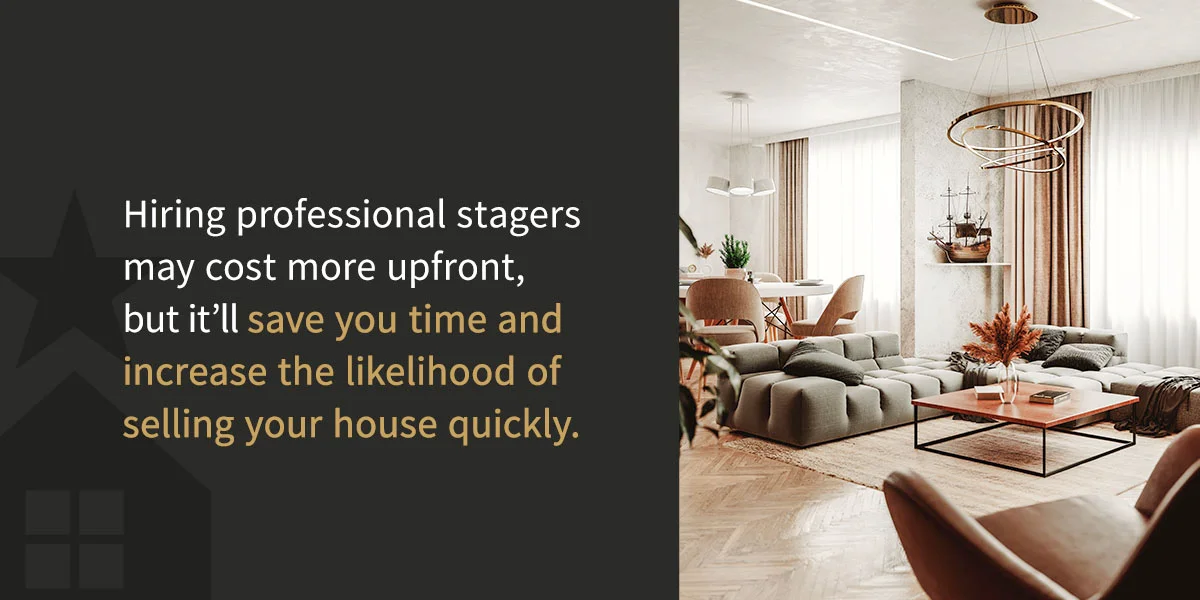At New Western, our vision is a world where every real estate transaction is simple, certain, and satisfying. Therefore, we promote strict editorial integrity in each of our posts.
Whether you are flipping houses or selling your family home, you want the sale to go as smoothly as possible. A lot of time, energy and money goes into getting your house ready to sell, and you may wonder if it is worth staging an empty house. The experts say “definitely”! Studies from Realtor.com indicate that staged houses sell faster and sell for more than the asking price. Why? Buyers want to feel inspired — not overwhelmed — by a potential home.
When it comes to staging, choosing which rooms to focus your attention on could make a big difference when it comes to your flip’s profitability and desirability. You may not be able to stage the entire home, so it’s important to prioritize your time and resources. According to the National Association of Realtors Profile of Home Staging, most buyers want to see the living room, kitchen and primary bedrooms fully staged, while other rooms can have smaller details.
As an investor, it’s easy to see why you may be tempted to sell the home as-is, but the numbers will definitely persuade you — 58% of buyer’s agents note that staging impacts a buyer’s opinion of the house, while 81% noted staging makes it easier for house hunters to picture themselves and their possessions filling the home. Staged homes also spend up to 50% less time on the market. Here’s how to stage your investment house and maximize your profit.
We could liken houses to canvases and works of art. When a home is “painted” with furniture, decor, appliances and inviting accessories, it has a way of speaking to potential buyers. When it’s an empty canvas, there is no emotion, no way for buyers to connect to the home. The space may feel clinical, cold or abandoned. Staging a house transforms it into a home with potential, value, function and a future.
Staging is crucial and has many benefits:
Staging a home doesn’t need to feel like you have taken on the role of an expert interior designer. Follow these actionable tips to make the staging process a breeze:

If you don’t have the time, skills or inclination to stage the empty house yourself, hire a pro. Hiring professional stagers may cost more upfront, but it’ll save you time and increase the likelihood of selling your house quickly. Generally, the larger the home, the more staging will cost. Keep in mind that most professional house stagers will require you to sign a three-month (minimum) contract that’s binding even if you sell the home within a day or two.
What does a professional stager provide? Depending on cost, services may include:
Choosing the DIY route can save you money, but you will need to consider how much time it’ll take. First, you have to find the right furniture. You may choose to buy or rent. If you’re a frequent flipper, it just might make sense to purchase your own pieces to use for staging. You may also choose to rent furniture, especially those larger pieces that you don’t want to store in between flips.
Once you have your furniture and large pieces lined up, lay out the space. When deciding on furniture placement, keep your end goal in mind: To create a welcoming space that doesn’t feel cluttered.
Next, give buyers ideas about how they can use the space by using so-called “soft techniques.” Tactics include using rugs to show where furnishings could go, in theory. Most buyers have a hard time imagining how they’d lay out a house, especially in empty rooms. Just be sure you choose the right size rugs. As a rule of thumb, leave 1 to 2 feet of floor exposed around rug edges in larger rooms, and 6 to 8 inches exposed in halls or entryways.
Optimize the home’s natural light, too. Use airy window treatments, open all the blinds and use strategically placed mirrors to maximize light. If your budget is limited, focus your efforts on the “money rooms” — the living room, primary bedroom and kitchen. Overall, aim for a neutral style that’ll appeal to the most buyers. No need to overdo it with bright colors or unique artwork. Final touches include fluffy towels and shower curtains in the bathrooms, pillows and throws on couches and beds, accessories in the kitchen and table lamps for warmth.
Use this section to introduce the following subtopics providing tips for how sellers can reduce the cost of staging:
Many important factors go into selling a house, and staging is undoubtedly one of the most effective strategies. If you are ready to sell your house or buy your next investment, New Western is here to help you navigate the housing market with confidence. At New Western, we make real estate investing more accessible to more people. We are the largest private source of investment properties, operating in most major cities across the states, with an extensive portfolio of investors.
Contact us today to find property matched to your portfolio and discover how to find financial freedom whether you are a buyer or seller.
Disclaimer: The information provided on this website does not, and is not intended to, constitute legal advice; instead, all information, content, and materials available on this site are for general informational purposes only.